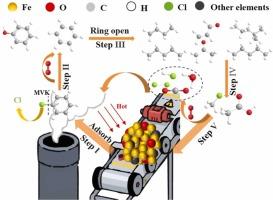Investigation on unrecognized catalytic contributing role of chlorobenzene oxidation by iron ore in sintering process
IF 7.8
2区 环境科学与生态学
Q1 ENGINEERING, CHEMICAL
引用次数: 0
Abstract
The iron ore sinter process produced large amount of volatile organic compounds (VOCs) emission due to its high dependence on fossil fuel. Meanwhile, sintering process features of moderate temperature and oxygen concentration, which will induce the in situ VOCs oxidation at interface of iron ore particles when VOCs generated at the same time due to the natural intrinsic physic-chemical characteristics of iron-bearing material. In this study, we first investigated the unrecognized catalytic contributing role of VOCs oxidation by iron ore in sintering process, of which is dominant pollution unit in long-term steel making industry. Chlorobenzene (CB) was taken as representative sinter flue gas chlorinated VOCs molecule, and its catalytic oxidation performance was investigated by 5 distinct iron ores originated from different iron smelts in China. It was evident that iron ores exhibited different CB oxidation performance, following the order of YD>MK>BG>JS>YJC. Especially, YD and MK reached 89.0 % and 81.0 % CB conversion at 550 °C. According to material characterization result, YD and MK exhibited orthorhombic FeO(OH) phase as dominant structure with higher Oβ/(Oα+Oβ) ratio than other ores. The catalytic CB oxidation performance under diverse reaction conditions were also evaluated. By combining GC-MS and in situ DFIFTs analysis, CB conversion path and Marse-van Krevelen mechanism were proposed.

烧结过程中铁矿石氧化氯苯未被认识的催化作用研究
铁矿烧结过程由于对矿物燃料的高度依赖,产生了大量的挥发性有机物(VOCs)排放。同时,烧结过程具有温度适中、氧浓度适中的特点,由于含铁材料天然固有的物理化学特性,在同时产生VOCs的同时,会诱发铁矿石颗粒界面处的原位VOCs氧化。在本研究中,我们首先研究了铁矿石在烧结过程中挥发性有机化合物氧化的未被认识的催化作用,烧结过程是长期炼钢工业的主要污染单元。以氯苯(CB)为代表的烧结烟气氯化VOCs分子,对其催化氧化性能进行了研究。铁矿的炭黑氧化性能表现为:YD>→MK>→BG>→JS>→YJC。尤其在550℃时,YD和MK的CB转化率分别达到89.0 %和81.0 %。材料表征结果表明,YD和MK的主要结构为正交FeO(OH)相,其Oβ/(Oα+Oβ)比值高于其他矿石。并对不同反应条件下的催化CB氧化性能进行了评价。结合GC-MS和原位DFIFTs分析,提出了CB转化路径和Marse-van Krevelen机理。
本文章由计算机程序翻译,如有差异,请以英文原文为准。
求助全文
约1分钟内获得全文
求助全文
来源期刊

Process Safety and Environmental Protection
环境科学-工程:化工
CiteScore
11.40
自引率
15.40%
发文量
929
审稿时长
8.0 months
期刊介绍:
The Process Safety and Environmental Protection (PSEP) journal is a leading international publication that focuses on the publication of high-quality, original research papers in the field of engineering, specifically those related to the safety of industrial processes and environmental protection. The journal encourages submissions that present new developments in safety and environmental aspects, particularly those that show how research findings can be applied in process engineering design and practice.
PSEP is particularly interested in research that brings fresh perspectives to established engineering principles, identifies unsolved problems, or suggests directions for future research. The journal also values contributions that push the boundaries of traditional engineering and welcomes multidisciplinary papers.
PSEP's articles are abstracted and indexed by a range of databases and services, which helps to ensure that the journal's research is accessible and recognized in the academic and professional communities. These databases include ANTE, Chemical Abstracts, Chemical Hazards in Industry, Current Contents, Elsevier Engineering Information database, Pascal Francis, Web of Science, Scopus, Engineering Information Database EnCompass LIT (Elsevier), and INSPEC. This wide coverage facilitates the dissemination of the journal's content to a global audience interested in process safety and environmental engineering.
 求助内容:
求助内容: 应助结果提醒方式:
应助结果提醒方式:


